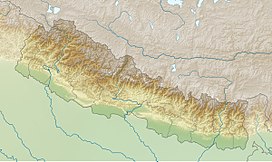Lhotse
| Lhotse | |
|---|---|

The South Face of Lhotse as seen from the climb up to Chukhung Ri.
|
|
| Highest point | |
| Elevation | 8,516 m (27,940 ft) Ranked 4th |
| Prominence | 610 m (2,000 ft) |
| Isolation | 2.66 kilometres (1.65 mi) |
| Listing | Eight-thousander |
| Coordinates | 27°57′42″N 86°56′00″E / 27.96167°N 86.93333°ECoordinates: 27°57′42″N 86°56′00″E / 27.96167°N 86.93333°E |
| Geography | |
| Location |
China (Tibet Autonomous Region) Nepal (Khumbu) |
| Parent range | Mahalangur Himal |
| Climbing | |
| First ascent | May 18, 1956 Fritz Luchsinger, Ernst Reiss (First winter ascent 31 December 1988 Krzysztof Wielicki) |
| Easiest route | glacier/snow/ice climb |
Lhotse (Nepali: ल्होत्से; Tibetan: ལྷོ་རྩེ) is the fourth highest mountain in the world at 8,516 metres (27,940 ft), after Mount Everest, K2, and Kangchenjunga. Part of the Everest massif, Lhotse is connected to the latter peak via the South Col. Lhotse means “South Peak” in Tibetan. In addition to the main summit at 8,516 metres (27,940 ft) above sea level, the mountain comprises the smaller peaks Lhotse Middle (East) at 8,414 m (27,605 ft), and Lhotse Shar at 8,383 m (27,503 ft). The summit is on the border between China, Tibet and the Khumbu region of Nepal.
An early attempt on Lhotse was by the 1955 International Himalayan Expedition, headed by Norman Dyhrenfurth. It also included two Austrians (cartographer Erwin Schneider and Ernst Senn) and two Swiss (Bruno Spirig and Arthur Spöhel), and was the first expedition in the Everest area to include Americans (Fred Beckey, George Bell, and Richard McGowan). The Nepalese liaison officer was Gaya Nanda Vaidya. They were accompanied by 200 local porters and several climbing Sherpas. After a brief look at the dangerous southern approaches of Lhotse Shar, they turned their attention, during September and October, to the Western Cwm and the northwest face of Lhotse, on which they achieved an altitude of about 8,100 metres (26,600 ft). They were beaten back by unexpectedly strong wind and cold temperatures. Under Schneider's direction they completed the first map of the Everest area (1:50,000 photogrammetric). The expedition also made several short films covering local cultural topics, and made a number of first ascents of smaller peaks in the Khumbu region.
...
Wikipedia

